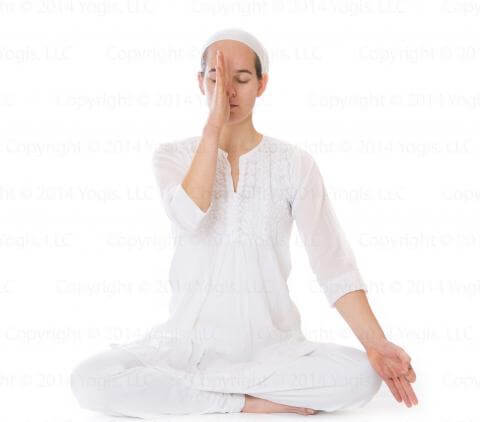Yogic philosophy teaches that breathing through specific nostrils activates different energy channels and parts of the brain. Read on to learn about how the simple technique of Left, Right, or Alternate Nostril breathing can be used to energize, calm yourself, or create a deep sense of well-being and harmony.
What It Is
Yogic philosophy teaches that the nostril on the right is our “sun nostril” which regulates our energy level, while the left nostril is our “lunar nostril” which regulates our emotions. The quality of prana processed through the two nostrils corresponds with the qualities associated with the two sides of the brain.
This is where we can see neuroscience and yogic science overlapping: the left hemisphere of the brain controls the logic-oriented, masculine sun-energy, and the right hemisphere controls intuition and creativity, which is influenced by feminine moon-energy. The nerves of these two brain hemispheres cross at the level of the eyebrows; the left hemisphere is connected to the right side of the body and the right nostril, whereas the right hemisphere is connected to the left side of the body and the left nostril.

What It Does
We breathe predominantly through one nostril or the other at any given time. The dominant nostril alternates rhythmically every 90 to 150 minutes. This rhythm is regulated through structures in the hypothalamus and pituitary, or the glands that dispense “calm, cozy, feel-good” hormones. Alternate nostril breathing can function as a tool that allows us to bypass our default breathing system and create a new rhythm that keeps us feeling good for longer.
This is especially important because our nervous system is directly linked to our breathing. When we are emotionally tense, the stress hormone cortisol begins flowing, our breath rate increases, and we may even begin to sweat. But when we are calm and relaxed, our breathing slows down, our body releases tension, and we feel more at ease and peaceful.
If we feel lethargic and fatigued, long deep breathing through the right nostril can give us added energy. On the other hand, breathing through the left nostril can provide a sense of peace and inner calm even in the midst of strong emotions.
Right Nostril Breathing
Breathing through the right nostril activates the Pingala and is associated with:
- Prana, the nurturing energy
- Sun energy—warming, projective
- Vigor
- Alertness
- Willpower
- Concentration
- Readiness for action
If you find yourself needing more energy, vigor, or alertness, find a quiet spot, close your left nostril with the forefinger of your right hand, and breath long, deep breaths exclusively through the right nostril for a few minutes.
Left Nostril Breathing
Breathing through the left nostril activates the Ida and is associated with:
- Apana, the cleansing energy
- Moon energy—cooling, receptive
- Calmness, inner peace
- Empathy
- Sensitivity
- Synthesis
When your energy is racing and you need to calm and soothe your nervous system, close the eyes, block the right nostril with the thumb of the right hand, and breathe long and deep through the left nostril for 3-5 minutes.

Alternate Nostril Breathing
Alternate nostril breathing is extremely helpful when we feel off-center but still must function in the everyday world. For instance, we may be scheduled for an important interview or business endeavor only to find ourselves nervous or irritable. This technique can help us calm down and be more effective in our communication.
When we breathe long and deep through alternating nostrils, the whole nervous system is soothed, calmed, and energized simultaneously. All that’s needed is 3–5 minutes of this pranayama and one’s whole nervous system can be revitalized.
Practice
Posture: Sit with a straight spine. You may be in Easy Pose or on a chair, wherever you can keep your spine straight and be comfortable.
Mudra and Breath: Using the thumb and index fingers of the right hand, make a “U” of the two fingers, using the thumb to close off the right nostril and the index finger to close off the left nostril.
Close the left nostril, inhale deeply through the right nostril. At the end of the inhale, close the right nostril and exhale through the left nostril.
Now inhale through the left nostril fully and deeply, then close the left nostril and exhale through the right one.
Again, inhale through the right nostril and continue alternate nostril breathing. The breath must be complete and full on both the inhalation and exhalation cycles.
Through this simple mechanism of closing or opening the nostrils, the yogi has a highly accessible breathing technique for regulating moods and energies.
Continue for 3 – 5 minutes. To end, inhale deeply, hold the breath a few seconds, lower the hand, and exhale.